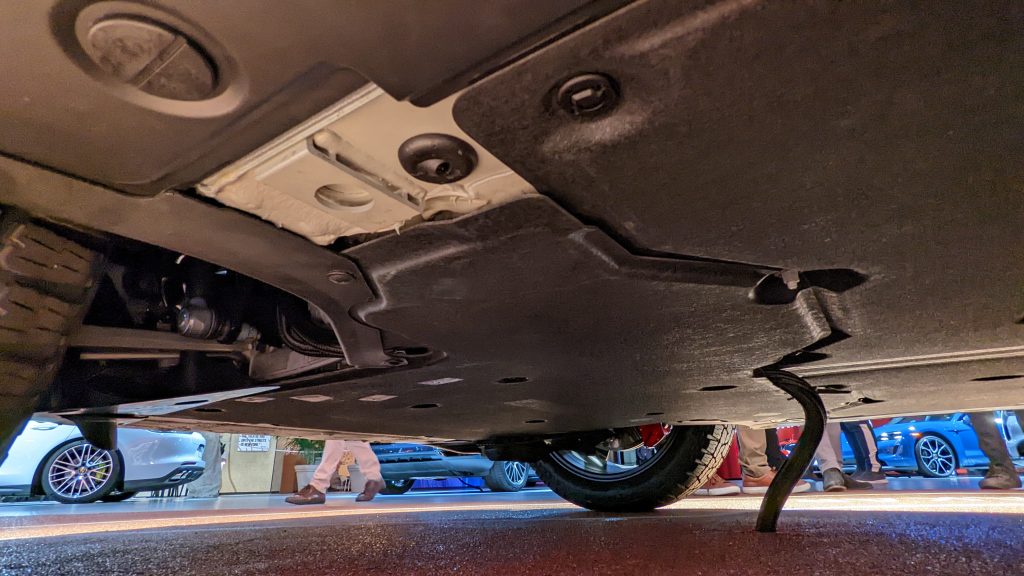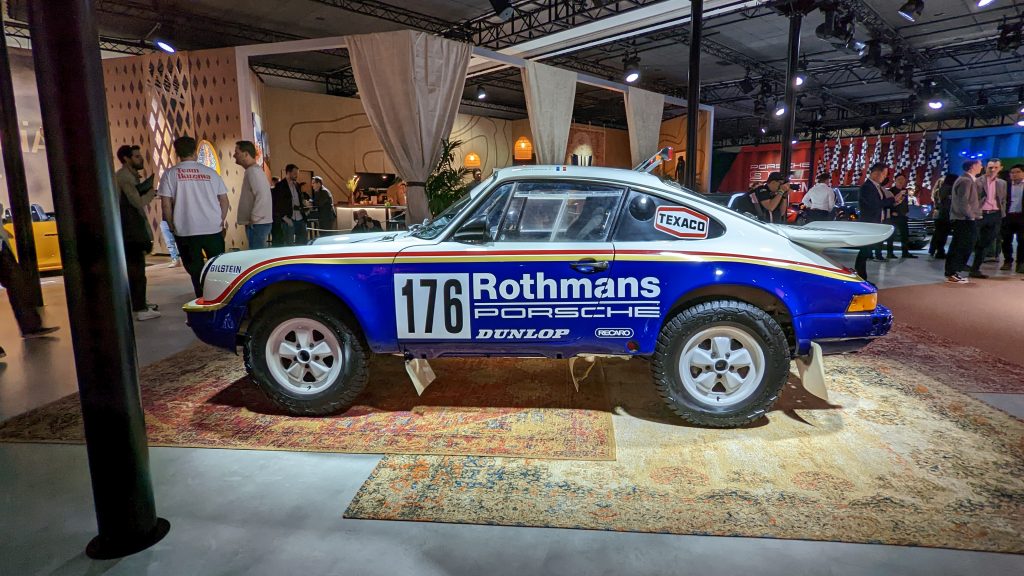Porsche just debuted the 2023 Porsche 911 Dakar, a “safari’d” (i.e. lifted, off-road-oriented) Porsche 911, and while I think the mere fact that it exists is awesome, looking at one here at the LA Auto Show leaves me with a few technical questions. Particularly, I’m confused about a few cooling system and off-road-related engineering decisions. Let’s talk about them.
With Porsche releasing a story about two portal axle-equipped 911s climbing a big volcano in Chile, and with a press release for the production version of the safari’d 911 reading “Taking Inspiration From The Rally Stages: The 2023 Porsche 911 Dakar,” you might think the Stuttgart-based sports car brand was building a genuine off-road beast. But a look at the production car here at LA Auto Show, where the vehicle made its global debut a few days ago, makes it clear that this thing is really meant to look cool and do some light dune bashing, but it won’t blast through tough off-road trails.
It’s Not Exactly Going To Be A Beast Off-Road

Obviously, just looking at the outside of the car makes it clear that it’s geometrically challenged as an off-roader. With a steel coil spring suspension, the car’s approach angle is a low 14.2 degrees, the departure angle is an also-low 16.4 degrees, and the breakover angle is a suboptimal 16.2 degrees, with ground clearance maxing out at only 6.3 inches. Add the adjustable suspension, and the ground clearance goes to about 7.5 inches, while the approach figure goes up to 16.1 degrees and the breakover angle goes to 19 degrees, per CNET. (I don’t have a departure figure, oddly).


Start looking underneath the Dakar, and the vehicle’s off-roading limitations become even more apparent:

Up front, the body-in-white (the bottom of the frunk) is exposed and lacking a skid-plate; that’s probably fine, though I’d be curious how that’d handle being bashed by big rocks on a rally course.



The underbody is flat, but largely covered by plastic shields. I won’t conjecture how well this will hold up when dragged over rocks, but I will guess how well these heat shields will stay in place, and that is: Poorly:

More importantly, look at that nylon engine oil pan just sitting right behind that rear axle, completely exposed — not a single skid plate in sight. Imagine bashing that on a rock and draining oil all over the terrain; yikes. There’s a reason why the Jeep Wrangler JL went from a nylon transmission oil pan (found on some prototypes) to a steel one for production cars.
Before I conclude this section about off-road capability, I have to make you all aware that someone wrote an absolutely astronomically detailed story about plastic oil pans. The article, titled “Autocomposites Update: Engine oil pans — As thermoplastic composites makes inroads into these complex, modular parts, weight and cost go down, functionality goes up” comes to us from Composites World, and the depth of this piece is unbelievably impressive to the point where, if you were to just click on the link and read that article instead of this one here, I honestly wouldn’t even be mad.
Look at the detailed description of the history of composite oil pan development:

As work got underway at DaimlerChrysler in 2007, a parallel program involving BASF and Dana started at Ford Motor Co. (Dearborn, MI, US) on the automaker’s 5.4L/3V (three-valve) V-8 engine for Ford’s F-150 pickups. This three-year effort yielded a 56- by 28- by 20-cm pan that, minus hardware, weighed only 2.24 kg. Also approved for implementation, this effort led to the team’s first North American commercial opportunity, on the 6.7L power-stroke turbo-diesel Scorpion engine in heavy-duty F-250 and F-350 pickups. The Scorpion engine was selected because Ford engineers wanted to integrate an oil level/temperature sensor in this engine’s 38 by 25 by 10 cm, 1.5-kg (fully dressed with hardware) nonstructural pan ― something that would’ve been difficult in stamped steel but straightforward in composites.
Launched in 2009, it was reportedly the first composite oil pan designed for exposed use (typical of North American vehicles without full underbody shields) thanks to a new material (Ultramid B3ZG7 OSI 35%-short-glass/PA 6) and a new waffle-rib configuration. The latter, for which BASF has patents pending, was developed and validated via extensive computer-aided engineering (CAE) analysis and impact testing. A proprietary modification package optimized the resin for stone impacts to -40°C and stabilized it against long-term heat aging in hot oil, bio-diesel and calcium chloride road salts (which normally attack polyamide).
Here’s why composite oil pans have become so popular these days:
Metal pans are heavy, prone to corrosion/rust and denting, feature numerous subassemblies (e.g., oil pick-up tube, windage tray, filter, pump, etc.) and require secondary machining, welding and painting. This is, therefore, just the kind of application where composites can integrate subcomponents, reduce assembly costs and roughly halve pan weight at a time when there is great pressure to improve fuel efficiency and reduce emissions. Further, composites naturally dampen noise/vibration/harshness (NVH) values.
And here’s a look at the future of composite oil pans:
Engine oil pans, at least in North America, appear to be evolving from nonstructural to structural designs. A development project underway between Ford, the US Department of Energy (DoE, Washington, DC, US), and the Vehma Engineering and Prototype Div. (Troy, MI, US) of Magna Exteriors (Aurora, ONT, Canada) is investigating a multi-material lightweight vehicle (MMLV) based on a C/D segment sedan where the goal is to produce a drivable prototype weighing 25% less than the benchmark (Mach I), and then create a “virtual” concept vehicle that is 50% lighter than the benchmark (Mach II). One target area for lightweighting on this program is a V6 structural oil pan that will contribute to overall powertrain stiffness. The Mach I design is a two-piece, glass-reinforced PA pan with a carbon fiber-reinforced composite bracket.
Anyway, my point is that nylon oil pans are actually quite sturdy, they’re just not ideal for off-road applications, just as exposed stamped steel ones aren’t. You want the pan to either be somewhere that’s unlikely to see an impact (like just above the front axle, in the case of the Jeep Wrangler JL) or protected with a skid plate. The Porsche’s pan is just aft of the rear subframe; drag the vehicle’s (plastic-covered) belly over a rock, and that pan will likely see some action. Clearly, this vehicle wasn’t built for that kind of action, even if you have read headlines like “The $222,000 Porsche 911 Dakar Will Take You (Almost) Anywhere.” Keep it on gravel roads and snow-covered lakes; or, more likely, in a garage in a fancy zipcode.

The old-school Porsche 911 Safari, on the other hand? This thing is legit. Look at how high it is off the ground, and look at how much better the approach, departure, and breakover angles are. Plus, check out all the underbody protection:




A Question About Aerodynamics
When I see a new car, the first thing I like to check out is the cooling system, as I used to get paid to stare at them and assess them. On the 911 Dakar, one thing has me a little confused.

See that grille opening below that black blanking plate to the right of the red tow hook? That opening doesn’t feed a heat exchanger — there’s nothing behind it:


In fact, if you stick your fingers into that opening, you find that it feeds the two vents in the hood, which is shared with the 911 GT3. Allow Jason to show you while looking really special:

What’s going on here? Why is a big cooling opening just feeding some vents in the hood? On a 911 GT3, there’s a heat exchanger behind that opening:




And on the 911T, that area is actually completely blocked off. Here’s the 911T:


So why does the Dakar have the opening that vents out the hood, but no heat exchanger? Porsche’s rep wasn’t sure, but implied that it might have just been a styling thing. Could there be an aero advantage? Seems unlikely to me, but maybe.


Anyway, I’ll conclude this by showing you this custom 1991 “Porsche 911 Carrera 4 Baja” made by Russell Built and currently on display at The Autopian’s booth at the LA Auto Show. With its high ground clearance, absurdly knobby tires, high-clearance fenders, and aluminum, sheet-steel, and carbon fiber skid plate treatment, the thing is clearly designed to be an off-road monster:








You know how Dylan Mulvaney is a woman? Well, the Porsche 911 Dakar goes off road.
Complete respect for your site!!! 953 ground clearance 270 mm. 911 Dakar 190 mm. What a joke. All the other sites read like ads. Should be viewed as 911 capable of dirt roads.
They look tough but I bet most will not even see a dirt road. These will primarily be asphalt cruisers and will look great in the Starbucks drive through.
It would appear this is more of a dirt road 911 than an off road 911.
Off-road the key difference between a plastic or cast ali sump and a steel one is that a steel one can be hammered straight with a rock and welded up with the worst cheapest stick welder the nearest goat farmer can muster, or brazed up with almost any source of heat.
I mean, maybe not a bad idea not having the cooler there anyway – the first trips down anything rough will put a stone through the front of it or clog it with dust and mud….but then the side coolers are still there so I guess it’s relegated to maybe climbing the odd kerb or two…
Too bad this doesn’t allow photo comments or I’d post all the gnarly scraped fins on the bottom of *my* Porsche’s oil pan. And that’s on a track build!
Anyway, I have never wanted to hoon anything as badly as I’ve wanted to hoon absolutely everything on this page. Parsh. PARSH! Let me jump it and see if it holds up. I am great at sending things. I have ample practice sending it! My rallycross beater earned the name “Space Shuttle” for a reason. Please, parsh. PLEASE. Send me the parsh to send it.
I think I’d have all that underbody panelling on that Porsche on the floor in pieces in the space of 500 yards. I’ve got quarter inch thick alloy plates under the back of my rear engined off roader and they take a beating even then.
So it looks like one group in Porsche decided to make an actual rally 911, and another group thought they were tarting up a 911 for SEMA?
I feel so much love that they read my comments, investigated my views, and supported them.
Thanks so much David for this in depth look at the off road capabilities of the 911 DAKAR. I met you Saturday while you were all checking out the 59 Metropolitan. My friend Kyle and I both thought the DAKAR was best in show, but now that I see how the undersized isn’t protected I’ve changed my mind!
Thank you for saying hi!
I mean, we all kinda knew it was going to be a little light on delivering anything close to the real Dakar experience. Still, Im bummed they didn’t at least go to the trouble of putting some kevlar panels or stamped boron steel panels in critical areas. I would like to know a little more about how they modified their AWD system and their “lift” system. Based on my research on the later, it seems like its pretty much just a hydraulic puck spacer lift. 30 mm taller, but not 33 mm more travel. On that topic, I would also like to ask what its like to drive off road with 4-5 inches of suspension travel.